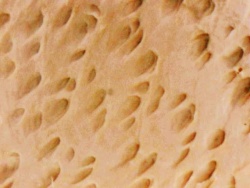Difference between revisions of "Crust leather"
m |
|||
| Line 56: | Line 56: | ||
* '''Filling''': Dense chemicals are added to make the leather harder and heavier. | * '''Filling''': Dense chemicals are added to make the leather harder and heavier. | ||
* '''Stripping''': Superficially fixed tannins are removed. | * '''Stripping''': Superficially fixed tannins are removed. | ||
| − | * '''[[Leather production#Softening|Softening]]''': Physical softening of the leather | + | * '''[[Leather production#Softening|Softening]]''': Physical softening of the leather by [[Leather production#Softening|tumbling and stacking]]. |
* '''[[Sanding leather|Buffing]]''': Abrasion of the surfaces of the leather to reduce nap or grain defects. | * '''[[Sanding leather|Buffing]]''': Abrasion of the surfaces of the leather to reduce nap or grain defects. | ||
Revision as of 21:58, 20 November 2016
Crust leather
Crust leather is leather, which is dried after tanning but has not yet been dyed. In the case of chrome-tanned leather, this is referred to as "chrome crust" or vegetable-tanned leather of "vegetable crust".
Crust leather is rarely processed as it is. Usually, the leather is dyed and finished before processing.
Vegetable crust - Chrome crust
Vegetable tanned crust leather processed.
Unusual: Chrome crust processed. The colouration only by chromium is not appealing. Therefore, a cheap solution.
Crusting
Crusting is part of the steps for leather production. The main stages in the leather production process are called, preparatory stages, tanning, crusting and surface coating.
Crusting is when the hide is thinned, retanned and regreased. Often a dye process is included in the crusting. Also, part of the crusting process involves drying and softening.
Crusting may include the following working steps depending on the type of leather:
- Splitting: The leather is split into one or more horizontal layers.
- neutralisation: The pH of the leather is adjusted.
- Retanning: Additional tanning imparts properties.
- Dying: The leather is coloured in the drum.
- Fixation: Unbound chemicals are chemically bonded or removed from the fibres.
- Whitening: The colour of the leather is lightened.
- Fatliquoring and Stuffing: Fats, oils and waxes are added between the fibres to soften the leather.
- Shaving: The leather is thinned using a machine which cuts leather fibres off the flesh side.
- Wetting and Conditioning: Leather has to be rehydrated depending on the following working steps.
- Sammying: Water is squeezed out the leather.
- Drying: The leather is dried to different moisture levels.
- Filling: Dense chemicals are added to make the leather harder and heavier.
- Stripping: Superficially fixed tannins are removed.
- Softening: Physical softening of the leather by tumbling and stacking.
- Buffing: Abrasion of the surfaces of the leather to reduce nap or grain defects.
Additional information













 a kotori web solution
a kotori web solution